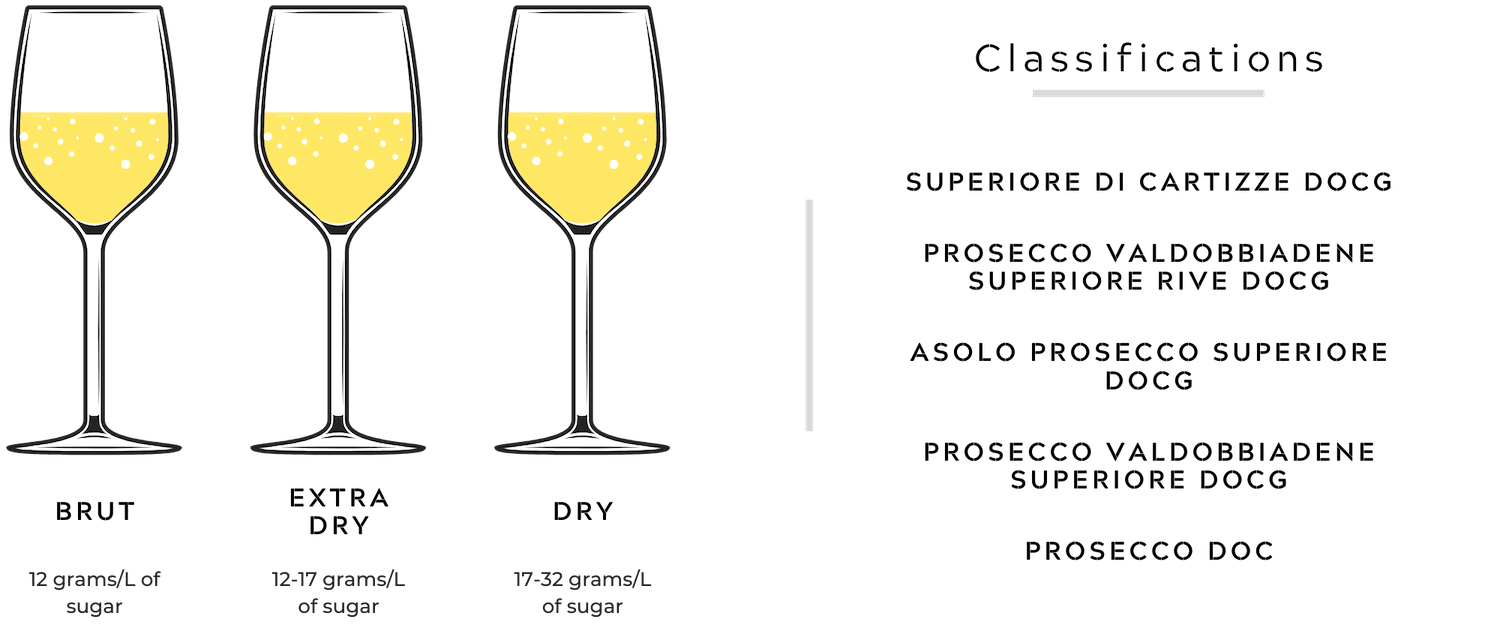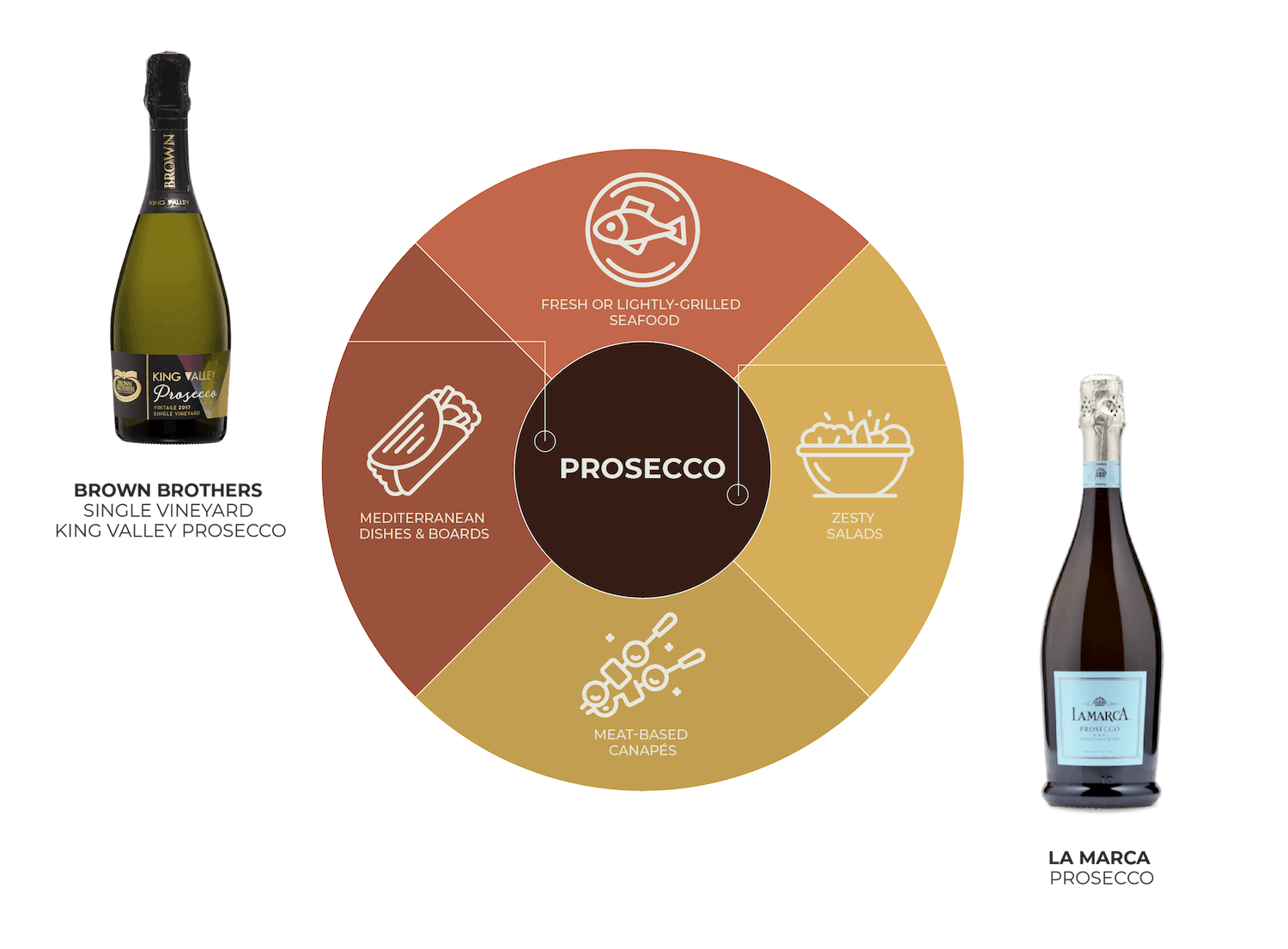Prosecco is easily the most recognisable style of sparkling wine outside of Champagne that is known for its affordable price tag and easy-drinking style.
Whilst it originates in Italy, bottles of sparkling wine made in the same style as Prosecco can and are made and found throughout other winemaking regions of the world, including Australia, though often bottled under different names.
If you’re keen to learn more about this incredibly popular style of sparkling wine continue on and read through this complete guide but for those looking for a quick snapshot of how these wines taste and pair with food, consider our handy graphic below.
From the wine's traditional home in north eastern Italy, Prosecco has seen an incredible and seemingly unstoppable period of growth both locally and globally.
Whilst the first mentions of the wine seem to appear around the late 16th century, it isn’t really until the middle of the 18th century that the term “Prosecco” as we know it today is found in the works of an esteemed Italian poet.
When looking into the history of the wine, it is important to note and remember that winemaking in the area from where Prosecco originates had existed for centuries, with mentions of still table wines being produced in the area being found since at least the times of the Greeks and Romans.
The name of the wine itself is derived from the ancient village of Prosecco, which is now a suburb of the major city of the area, Trieste.
Under European Union laws, only those wines originating from the Prosecco wine-producing regions of Veneto and Friuli can have that name shown on the bottle.
To find out more on the historical development of the wine over time, consider the information found in this insightful article.
Whilst Prosecco is a type of sparkling wine, just the same as Champagne is, it is made using a completely different process than is practiced in the production of that wine from France and using different grape varietals, affecting taste.
Without going too much into the technicalities of how these wines are produced, Prosecco undergoes secondary fermentation, which is where the carbonation in sparkling wine forms, in stainless steel tanks rather than inside of the bottle itself, which is the case with Champagne, making Prosecco far cheaper to produce and usually devoid of the yeasty flavours of bread, smoke, and nuts often found in Champagne.
Not only are Prosecco wines made in a different fashion, they also primarily use the glera grape varietal, among a small number of other grape varietals, which is different to Champagne that primarily uses a blend of the chardonnay, pinot noir, and pinot meunier grape varietals.
All of these differences combine to make bottles of Prosecco taste decidedly more fresh and fruity in their flavour profile, with notes of pear, apple, and honeysuckle shining through in a wine with usually more aggressive levels of carbonation and a somewhat foamier mouthfeel.
Though they are often considered sweeter than bottles of Champagne due to their fruitier flavour profile, it is actually possible and more often the case that Prosecco wines are made in a typically dry style.
To find out more about the taste of these wines, consider the information found in this article.
As discussed previously, bottles of authentic Prosecco are only produced within the two winemaking regions of Veneto and Friuli located in north eastern Italy.
Wines made in a similar fashion can be found throughout other parts of Italy and the world, however, it is only within the legally protected areas of the Prosecco wine-producing zone that bottles of authentic Italian Prosecco are found.
Within this zone, bottles of Prosecco are further classified based upon the particular sub-region from which they originate and how much sugar is contained within the wine, which helps to allude to the quality and taste of the liquid in the bottle.
Whilst most bottles of Prosecco found in bottle shops and restaurants throughout the world will be labelled as “Prosecco DOC”, it is possible, though rare, to find bottles labelled as “Superiore di Cartizze”, which use grapes that have come from special vineyards making up just a couple hundred acres.
Although Prosecco has traditionally only been produced in Northern Italy, winemakers in the cooler climate wine-producing regions of Australia have begun making glera-based wines in ever increasing abundance since the early 2000s.
Known for its fruitier and characteristically “fresher” taste and flavour profile, bottles of Australian Prosecco will only feature the name “Prosecco” when found in the domestic market, with those bottles marked for export being legally obligated to use a different name.
By far the most important wine-producing area for Australian Prosecco is the King Valley region in Victoria, where Italian migrants have established themselves since at least the 20th century.
Whilst other higher altitude and cooler climate wine-producing regions, such as Adelaide Hills, also produce Australian bottles of Prosecco, it is best to start with those wines coming from the King Valley.
In the cool climate of the King Valley wine-producing region, located in north-eastern Victoria, Italian immigrant families and winemakers have been producing Italian-style wines for decades.
The so-called “Prosecco Road” that runs through the region separates many of the important wineries in the area and is the most important conduit through which many tourists and visitors to the area take their journey.
Being a cool climate region, the King Valley is known for producing Prosecco wines with excellent levels of acidity and flavours of crisp and fresh pear, apple, and lemon, all within a somewhat creamy-style wine with a strong amount of carbonation that tends to fade typically faster than is the case with bottles of Champagne.
Prosecco wines, courtesy of their bright, fizzy, and typically dry and fruity style are wonderfully refreshing on their own and often served at the beginning of a party as an aperitif style wine.
That being said, it is possible to enjoy your favourite bottle of Prosecco with a range of food types and cuisines, creating unforgettable food and drink pairing experiences.
Whilst they can come in slightly variable styles from dry to moderately sweet, almost any bottle of Prosecco is best served alongside Mediterranean-style dishes or boards, meat-based canapés, fresh or lightly grilled seafood dishes, and zesty salad dishes.
There's a bottle of Prosecco out there for everyone. Here are some of the brands and bottles that we recommend you look out for the next time you're browsing online or in-store.
Learn how to pick the right bottle of Gewurztraminer wine for you and your tastes when browsing online or in-store in our beginners guide to the style with graphics.
With bottle shops expanding their range, we’ve taken the time to explain why some wines are and some are not vegan & organic in order to help you choose wisely.
Ready to begin your journey into the world of wine but don’t know where to start? Here’s our primer on what bottles & styles to try when just starting out.





